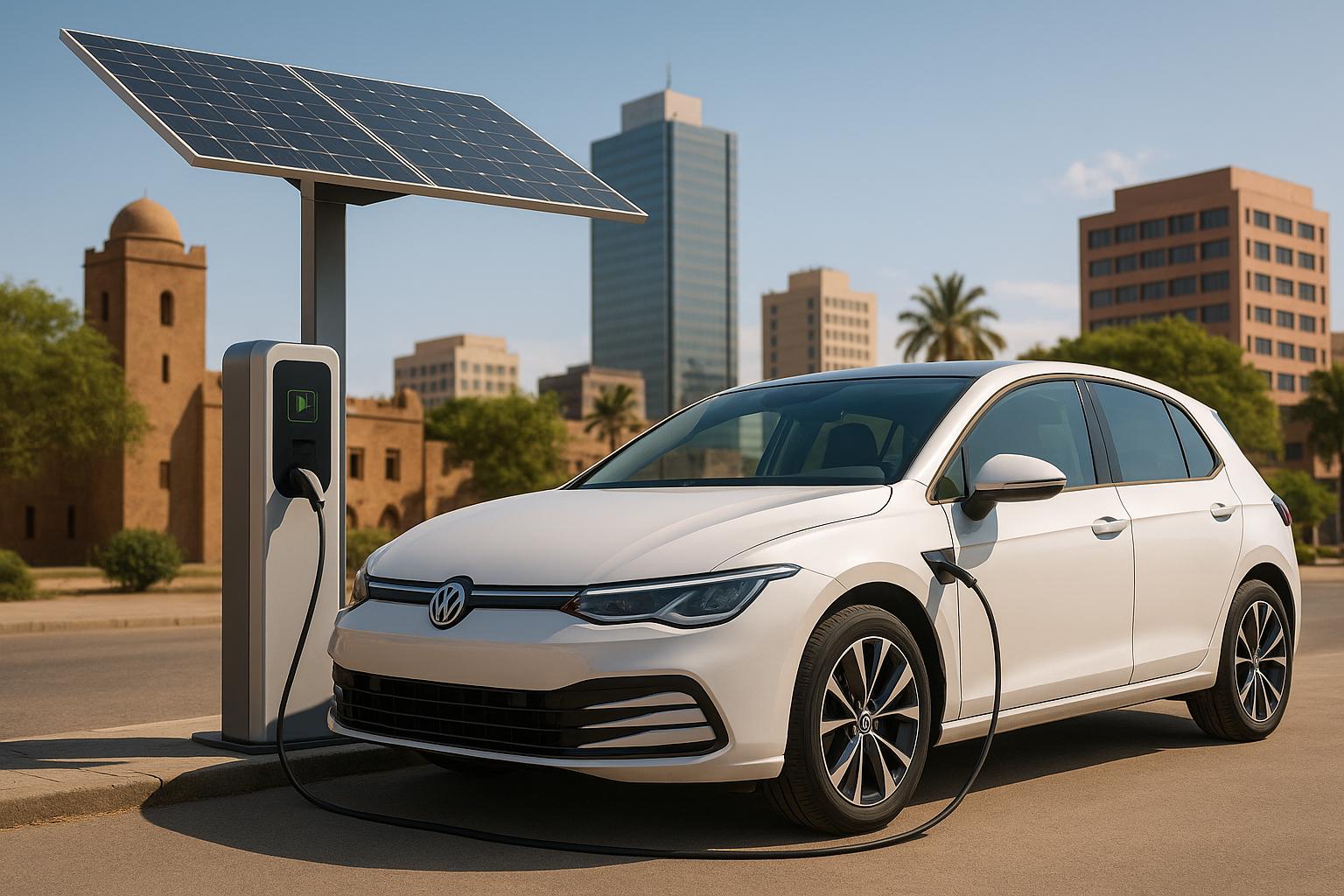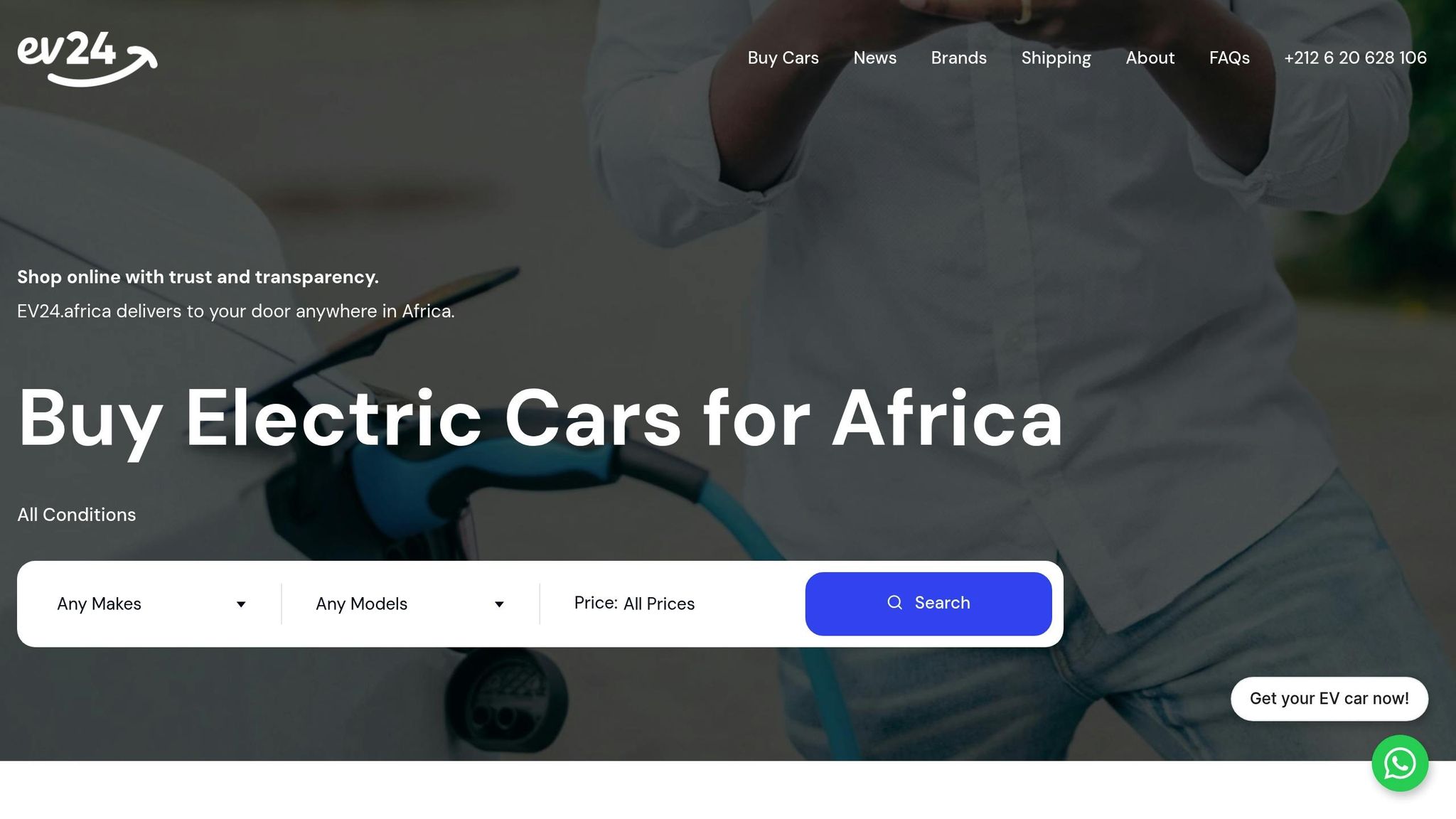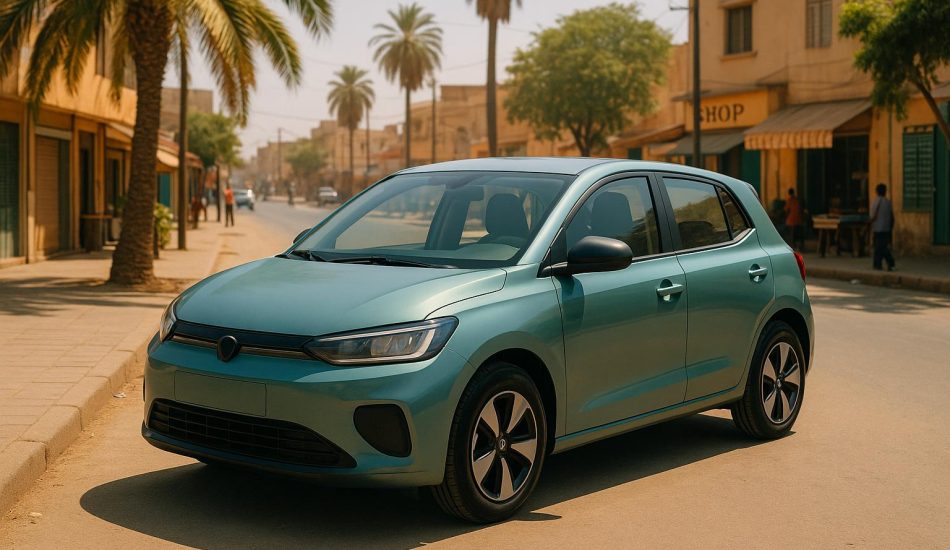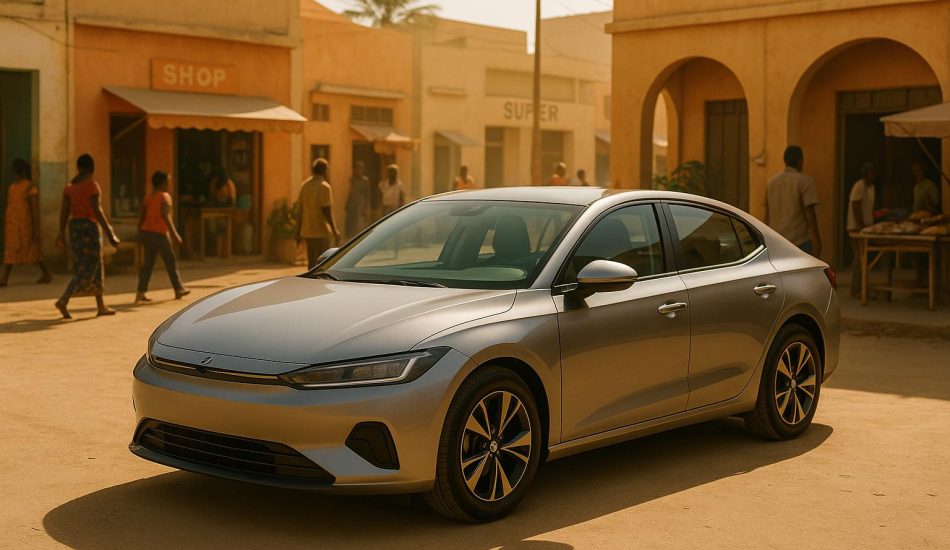
Africa’s electric vehicle (EV) market is growing but still lags behind global adoption rates. In 2024, only 11,000 EVs were sold in the region, compared to 17 million worldwide. However, several factors suggest that EV adoption could accelerate by 2030:
- Rising Fuel Costs: EVs offer lower operating costs, saving drivers up to $3,900 annually in some regions.
- Government Incentives: Countries like Rwanda and Kenya are introducing tax exemptions and reducing import duties to encourage EV adoption.
- Infrastructure Development: Solar-powered charging stations and battery-swapping networks are addressing infrastructure gaps.
- Focus on Two- and Three-Wheelers: These vehicles dominate Africa’s transport sector and are increasingly being electrified.
Projected EV sales could climb to 4.9 million units by 2040, driven by local manufacturing, renewable energy integration, and innovative business models. While affordability and infrastructure remain challenges, strong policy support and private investments are laying the groundwork for growth.
SA’s fully electric fleet to reach 22 500 cars by 2030 – report
Market Forces Driving EV Growth
Several key factors are coming together to boost electric vehicle (EV) adoption across Africa. These drivers are setting the stage for a major transformation in the continent’s transportation landscape by 2030.
Government Policies and Incentives
African governments are rolling out policies and incentives to kickstart their EV markets, and the results are already making waves in several countries.
In Ghana, duty waivers and a focus on electric two- and three-wheelers have propelled the country to the top spot with 17,000 EVs on the road. Morocco follows with 10,000 EVs and over 400 charging stations, supported by a growing export market. South Africa, with approximately 6,000 EVs, has eliminated import duties entirely to encourage adoption.
Rwanda and Kenya are also stepping up with comprehensive incentive packages. Rwanda’s tax framework, active until June 30, 2028, exempts EVs from VAT, customs duties, excise duty, and withholding tax. Kenya, on the other hand, has halved the excise duty on EVs from 20% to 10% and removed VAT on fully electric vehicles. Additionally, Rwanda offers a reduced EAC external tariff of 25% for EVs priced under $60,000 CIF value.
South Africa is focusing on manufacturing. Finance Minister Enoch Godongwana detailed the country’s strategy:
"The Electric Vehicles White Paper outlines our strategy to transition towards broader new energy vehicle production and consumption in South Africa, starting with electric vehicles. It aims to transition the automotive industry from primarily producing internal combustion engine vehicles to a dual platform that includes electric vehicles, by 2035."
To support this shift, South Africa plans to introduce a 150% tax incentive for manufacturers investing in electric and hydrogen vehicle production by March 2026. This is significant, given that the automotive sector contributes 5.3% to the country’s GDP.
By 2025, over a dozen African nations are expected to have national EV policies in place, signaling a strong commitment to electric mobility. These reforms are laying the groundwork for economic growth and widespread EV adoption.
Impact of Rising Fuel Costs
Soaring fuel prices are making EVs a more cost-effective option for individuals and businesses across Africa. The financial benefits are becoming increasingly clear.
In nearly all sub-Saharan African countries (except Liberia), EVs offer lower per-kilometer costs compared to traditional vehicles. For example, in the Democratic Republic of Congo and Zambia, the savings can exceed $0.15 per kilometer, translating to annual savings of about $3,900 for high-mileage drivers.
The benefits are especially noticeable for commercial drivers. Electric motorcycle riders, for instance, see a significant increase in their take-home income, improving their financial stability.
Latiff Cherono, Chief Operations Officer at Gearbox Europlacer, highlighted the potential for profit:
"Electric vehicles represent a high-tech industry with strong value potential – owners of EVs or e-motorbikes can earn profit margins of up to $700."
McKinsey estimates that widespread EV adoption could lead to national savings of up to $10 billion in Nigeria by 2040. These savings are prompting both governments and businesses to prioritize EV transitions.
High fuel costs disproportionately impact low-income families and small businesses in urban areas. EVs offer a more equitable solution, particularly in sectors like Kenya’s boda boda (motorcycle taxi) industry. Employing 1.5 million people and contributing $1.8 billion annually to the economy, this sector stands to gain significantly from fuel cost reductions.
Renewable Energy Integration
Africa’s growing renewable energy sector is another critical factor supporting the rise of EVs. The continent’s clean energy resources are paving the way for a sustainable transportation future.
Currently, wind and solar power account for 8% of Africa’s energy generation. This rapid growth is enabling the development of EV charging infrastructure powered by locally-generated, clean electricity.
The benefits go beyond environmental impacts. Decentralized systems like solar home kits and microgrids are expanding electricity access in rural areas, which could help bring EVs to underserved communities. This is particularly important as urbanization continues and transportation needs extend beyond major cities.
African governments are starting to recognize the synergy between renewable energy and electric mobility. Policies are being developed to establish feed-in tariffs and ensure proper battery recycling and waste management practices, creating a more sustainable EV ecosystem.
Powering EVs with renewable energy also addresses a key challenge: reducing dependence on imported petroleum. By leveraging local energy resources, countries can build a more resilient and self-reliant transportation system.
However, achieving these goals requires careful planning. Governments must evaluate their energy systems thoroughly and invest in workforce training to develop the expertise needed to design and maintain modern energy infrastructure.
Barriers to Mass EV Adoption
Even with promising market trends, several hurdles are slowing the widespread adoption of electric vehicles (EVs) across Sub-Saharan Africa. Tackling these challenges is key for the region to fully embrace EVs by 2030.
Affordability and Access Issues
The steep upfront cost of EVs remains a significant barrier for many consumers in Sub-Saharan Africa, where economic constraints are already a challenge.
Adding to the issue is the overwhelming preference for used internal combustion engine (ICE) vehicles. These make up 70% of all vehicle imports in the region, a figure expected to climb to 85% by 2030. Nigeria, for instance, imports 80% of its ICE vehicles as used cars.
While EVs are cheaper to operate and maintain over time, limited financing options and their association with luxury make them less accessible to the average buyer, despite their long-term savings potential.
There is, however, a glimmer of hope. Projections suggest EV sales in leading Sub-Saharan African markets could surpass 700 million units within five years and grow to 4 million by 2037. As costs drop and financing improves, the market could expand rapidly.
Infrastructure Gaps
The lack of reliable infrastructure is another major obstacle. Frequent power outages and a scarcity of public charging stations make owning an EV challenging.
In Kenya, for example, unmanaged home charging could increase peak electricity demand by 24% if the country achieves its 5% EV adoption target. Additionally, drivers charging at 45% battery levels instead of waiting until 30% could push peak demand up by 2.5 times.
Range anxiety compounds these issues. In Nairobi, only 15% of matatu routes and 60% of bus routes can be completed on a single charge, underscoring the need for better charging infrastructure. Moreover, if electricity is sourced predominantly from fossil fuels, the environmental benefits of EVs are reduced.
Some innovative solutions are starting to emerge. In March 2025, CHARGE launched South Africa’s first off-grid, solar-powered EV charging station in Wolmaransstad, North West. The company plans to build 120 such stations along major highways, aiming to ease range anxiety for EV owners.
Market Fragmentation
Africa’s diverse economic and political landscapes create further challenges for establishing a unified EV ecosystem. Regional differences and varied consumer preferences make cohesive growth difficult. Nonstandardized battery packs also complicate the adoption of battery-swapping technologies. Furthermore, inconsistent regulations across borders deter investment and hinder market development.
Despite these challenges, the market shows promise. Africa’s EV industry is projected to reach $15.80 billion by 2025, growing at an annual rate of 10.20% through 2033. Currently, with about 50,000 units sold annually, the market is expected to grow at a 30% annual rate, potentially reaching 250,000 units by 2029.
Some companies are finding ways to navigate this fragmented landscape. For example, in June 2024, Kigali-based Ampersand partnered with Chinese EV manufacturer BYD to advance electric motorbike production in Africa. This collaboration aims to produce 40,000 electric motorcycles by the end of 2026, using batteries sourced from BYD.
As Eric Hannon, a partner at McKinsey’s Center for Future Mobility, remarked:
"How we get there is not written in stone. Frankly, we’re moving too slow. We aren’t on a trajectory that gets us there yet."
Overcoming these barriers will be essential as the industry moves toward a pivotal moment by 2030.
Comparison Table: EVs vs. Gas Vehicles
The table below highlights key differences between EVs and gas-powered vehicles, illustrating the challenges that hinder widespread EV adoption.
| Factor | Electric Vehicles | Gas Vehicles |
|---|---|---|
| Upfront Cost | Higher purchase price; limited financing options | Lower initial cost, especially used vehicles (70% of SSA imports) |
| Operating Costs | Lower per-kilometer costs | Higher fuel costs |
| Maintenance | Fewer moving parts; lower maintenance needs | Regular oil changes and engine servicing required |
| Infrastructure | Requires charging stations and stable electricity | Benefits from an established gas station network |
| Environmental Impact | Zero direct emissions; depends on electricity source | Direct CO2 emissions and air pollution |
| Range & Refueling | Limited range; longer charging times; range anxiety | Longer range; quick refueling |
| Market Perception | Seen as a luxury or early-adopter technology | Familiar, widely accepted technology |
sbb-itb-99e19e3
Regional Case Studies and EV Market Data
Expanding on earlier discussions about market drivers, regional case studies shed light on how Africa’s electric vehicle (EV) ecosystem is taking shape.
Leading Markets: South Africa and Others
South Africa stands out as Africa’s most developed EV market, thanks to its established automotive infrastructure and expanding charging networks. A notable example is CHARGE’s solar-powered charging station in Wolmaransstad, capable of charging six vehicles at once. It’s the first of 120 planned stations, spaced roughly 93 miles apart along major routes. Meanwhile, Ethiopia made headlines in 2024 by banning petrol and diesel car imports and deploying 100,000 electric vehicles. Morocco and Egypt each recorded over 2,000 new EV sales in 2024. Kenya is aiming high with a framework targeting 100% EV adoption by 2050, while Rwanda has positioned itself as a regional EV hub with zero VAT and duty exemptions on electric vehicles.
These varied strategies highlight the diverse approaches African nations are using to drive EV adoption.
Case Studies of Successful EV Programs
Several companies are tackling Africa’s unique challenges with innovative EV solutions tailored to local needs.
- Ampersand operates in Rwanda and Kenya, offering electric motorcycles paired with battery swap stations. This model not only cuts emissions but also lowers costs for drivers and improves urban air quality.
- BasiGo collaborates with public transport operators in Nairobi, providing electric buses as a cleaner, more cost-effective alternative to diesel buses. These buses are transforming the commuter experience in a city projected to house 10 million residents by 2050.
- Zembo in Uganda focuses on locally manufacturing electric motorcycles and advancing battery technology. By doing so, they’re creating jobs and building technical expertise while promoting green economic growth.
"These successful e-mobility initiatives share several key factors: supportive government policies, private sector investment, and innovative business models that address local needs."
CHARGE’s off-grid solar-powered charging station in South Africa is another standout example of progress in EV infrastructure.
These efforts collectively support the continent’s broader EV market growth, especially in the increasingly popular two- and three-wheeler categories.
Growth in Two- and Three-Wheeler EVs
The electric two- and three-wheeler segment is emerging as one of Africa’s most promising EV markets. Motorcycles, a staple of transportation across the continent, have seen their numbers in Sub-Saharan Africa grow from under 5 million in 2010 to over 27 million by 2022.
Although the current number of electric two- and three-wheelers is still in the low tens of thousands, projections suggest they could account for at least 50% of all motorcycle sales by 2040. This growth is driven by the fact that 80–90% of motorcycles in Africa are used for commercial purposes.
- Transsion, with its TankVolt e-bikes, has become a major player in Uganda, Nigeria, Kenya, Tanzania, and Ethiopia. As of June 2025, it ranks among Africa’s top three EV brands by units sold.
- In Ghana, KOFA introduced premium battery-powered motorcycles with battery swap stations, while Swap Station Mobility in Lagos chose TankVolt after testing multiple EV brands in late 2024.
The UN Environment Programme is also backing electric two- and three-wheeler projects in nine African countries, including Ethiopia, Kenya, Rwanda, and Uganda.
"Africa’s electric two- and three-wheeler market presents a tremendous opportunity for venture investment and sustainable economic growth."
Regional Comparison Table
| Country | 2024 EV Sales | Key Policy Support | Infrastructure Status | Market Focus |
|---|---|---|---|---|
| Ethiopia | 100,000 units | Banned ICE vehicle imports (2024) | Developing charging network | All vehicle types |
| South Africa | Growing steadily | Tax incentives, infrastructure investment | 120 planned solar charging stations | Passenger vehicles |
| Kenya | Increasing adoption | 10% import duty; 100% EV target by 2050 | Urban charging development | Buses, motorcycles |
| Morocco | 2,000+ units | Government incentives | Expanding public charging | Passenger vehicles |
| Egypt | 2,000+ units | Policy development phase | Limited but growing | Passenger vehicles |
| Rwanda | Strong growth | Zero VAT, duty exemptions | Battery swap networks | Motorcycles, commercial |
| Uganda | Emerging market | Local manufacturing support | Basic infrastructure | Motorcycles, local production |
The data reveals that while countries like South Africa and Morocco are following more traditional EV adoption patterns, East African nations such as Kenya, Rwanda, and Uganda are driving innovation with a focus on two- and three-wheeler EVs. These efforts are bolstered by strong government policies and a thriving fintech ecosystem.
2030 Outlook: Will This Be the Breakthrough Year?
The year 2030 could mark a turning point for Africa’s electric vehicle (EV) market – if key factors come together.
Market Projections Through 2030
Africa’s EV market is expected to grow significantly by 2030. Forecasts suggest the market value could rise from $17.41 billion to $28.30 billion, with accessible two- and three-wheelers potentially cutting CO₂ emissions by 24% and other pollutants by up to 25%. In Ethiopia, Kenya, Nigeria, Rwanda, and Uganda, EV sales may climb to between 3.8 and 4.9 million units by 2040, a sharp increase from the estimated 340,000 to 820,000 units projected for 2025. These numbers highlight the urgency of addressing critical market needs.
Key Requirements for Success
For 2030 to be a pivotal year, several things need to happen: scaling up charging infrastructure, cutting costs through local manufacturing, and increasing access to financing. Kenya Power, for instance, is investing $1.9 million in charging stations over three years, while the National Building Code now requires that 5% of commercial parking spaces be designated for EV charging. Additionally, between $3.5 billion and $8.9 billion will be necessary to fund vehicles, local assembly plants, and charging infrastructure.
Local manufacturing is gaining traction. In July 2024, Afrigreen Automobile, a Kenyan company, partnered with Chinese manufacturer Chery in a $20 million deal to build an assembly plant capable of producing 5,000 to 6,000 EVs annually. Kayode Adeyinka, CEO of Gigmile, emphasized:
"You really can’t bring down the cost of a product if you don’t have significant control over its production."
Government policy is also playing a critical role. South Africa introduced a 150% tax deduction for EV manufacturers in January 2025, effective from March 2026 through March 2036, alongside a $54 million public investment aimed at attracting $1.6 billion in private capital. Similarly, Rwanda has eliminated VAT on EV imports and is offering rent-free land for charging providers – showing how bold policies can accelerate adoption.
Role of EV24.africa in Market Growth

EV24.africa is helping to drive market growth by improving access to information. The platform provides transparent pricing, financing options, and details on government incentives. In a region where Sub-Saharan Africa has the lowest EV transition rate globally, EV24.africa’s presence across 54 countries helps streamline market operations and build consumer trust with detailed product specifications and customer reviews.
Africa’s EV Sales Future
The two-wheeler and three-wheeler segments are poised to lead Africa’s EV market by 2030. A mix of supportive policies, local manufacturing efforts, and platforms like EV24.africa is setting the stage for rapid growth. Tom Courtright of the Africa E-Mobility Alliance summed up the momentum:
"TankVolt has clear advantages in leading Africa’s e-bike market in terms of capital, manufacturing capability, and supply chain expertise. Transsion can scale much quicker than most local startups."
The progress in countries like Rwanda and South Africa serves as a roadmap for broader adoption across the continent. With millions of EVs expected on African roads by 2040, 2030 could be the year when early adoption transitions into widespread use. But this will depend on sustained investments in infrastructure, innovative financing models, and continued policy support. The groundwork is being laid – now it’s about turning potential into reality.
FAQs
What challenges does Africa face in adopting electric vehicles by 2030, and what solutions could drive progress?
Africa faces numerous hurdles in transitioning to electric vehicles (EVs) by 2030. Limited charging infrastructure, the high upfront cost of EVs, and weak government policies are among the primary obstacles. On top of that, poor road conditions in certain regions and low public awareness about the advantages of EVs further delay progress. A major concern for many potential buyers is range anxiety, or the fear of running out of charge before reaching a destination.
To address these issues, governments and private stakeholders can take meaningful steps. Offering tax incentives, subsidies, and grants could help make EVs more affordable for consumers. Expanding charging station networks, especially those powered by renewable energy, is another critical step. Public awareness campaigns can play a key role in educating people about the long-term savings and environmental benefits that EVs offer. With a collaborative approach, Africa could make measurable progress in embracing EVs by 2030.
How are government policies and incentives driving EV adoption in African countries like Rwanda and Kenya?
Government policies and incentives are playing a major role in accelerating the adoption of electric vehicles (EVs) in countries like Rwanda and Kenya. By reducing costs and investing in infrastructure, these governments are making EVs more accessible to their populations.
In Rwanda, the government has introduced full tax exemptions on electric vehicles. Starting in July 2025, EVs will be free from VAT, customs duties, and excise taxes, significantly lowering their cost for consumers. On top of that, tax relief is being offered on charging equipment and batteries, making the shift to electric mobility even more appealing.
Kenya has also rolled out strong incentives to encourage EV adoption. These include reduced import duties (10%), lower excise taxes (10%), and a 0% VAT rate for electric vehicles. The country’s National E-Mobility Strategy sets an ambitious goal: by 2025, 5% of vehicles on Kenyan roads should be electric. This policy not only supports affordability but also promotes investment in charging infrastructure and related technologies, paving the way for a more sustainable transportation future.
How does renewable energy support the growth of electric vehicles in Africa, and what are the key benefits and challenges?
Renewable energy is shaping the future of electric vehicles (EVs) in Africa by tapping into the continent’s vast solar and wind potential. These clean energy sources can power EV charging stations sustainably, cutting down on the need for imported fuels and reducing long-term costs for consumers and businesses alike.
By integrating renewable energy, Africa has the opportunity to create a cleaner transportation system, enhance energy self-sufficiency, and boost economic growth. That said, challenges like unstable power grids, inconsistent energy supplies, and insufficient infrastructure still pose significant obstacles. Overcoming these hurdles will require targeted investments in smart grids, advanced energy storage technologies, and government policies that support a dependable and widely available charging network for EV users.




